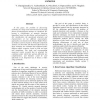Free Online Productivity Tools
i2Speak
i2Symbol
i2OCR
iTex2Img
iWeb2Print
iWeb2Shot
i2Type
iPdf2Split
iPdf2Merge
i2Bopomofo
i2Arabic
i2Style
i2Image
i2PDF
iLatex2Rtf
Sci2ools
ICNS
2007
IEEE
2007
IEEE
Data fusion algorithms for network anomaly detection: classification and evaluation
In this paper, the problem of discovering anomalies in a large-scale network based on the data fusion of heterogeneous monitors is considered. We present a classification of anomaly detection algorithms based on data fusion, and motivated by this classification, the operational principles and characteristics of two different representative approaches, one based on the Demster-Shafer Theory of Evidence and one based on Principal Component Analysis, are described. The detection effectiveness of these strategies are evaluated and compared under different attack scenarios, based on both real data and simulations. Our study and corresponding numerical results revealed that in principle the conditions under which they operate efficiently are complementary, and therefore could be used effectively in an integrated way to detect a wider range of attacks..
Computer Networks | Data Fusion | Heterogeneous Monitors | ICNS 2007 | Principal Component Analysis |
Related Content
| Added | 03 Jun 2010 |
| Updated | 03 Jun 2010 |
| Type | Conference |
| Year | 2007 |
| Where | ICNS |
| Authors | Vasilis Chatzigiannakis, Georgios Androulidakis, K. Pelechrinis, Symeon Papavassiliou, Vasilis Maglaris |
Comments (0)

